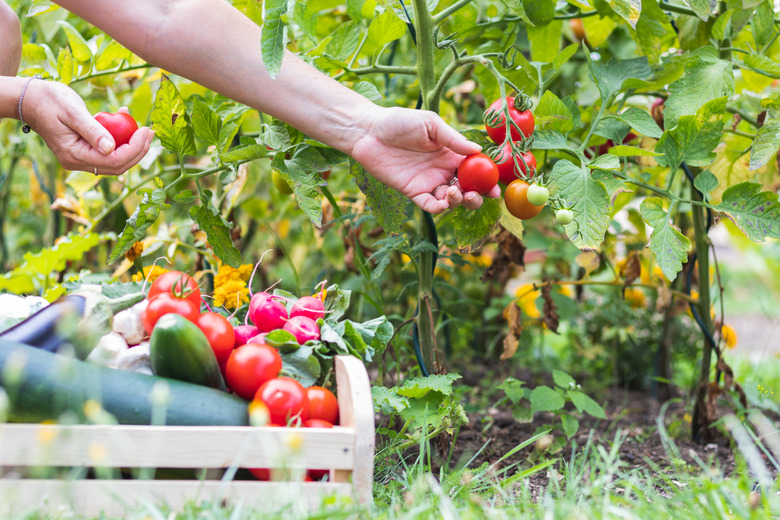How Much Nitrogen Can I Put On My Vegetable Garden?
How much nitrogen should go in your vegetable garden is primarily based on the type of vegetable you grow, since each type has different nutrient requirements. Nitrogen is viewed to be the most important of all the nutrients in fertilizers and is required by all plants to keep them from turning yellow and withered. Nitrogen is also the most difficult nutrient to measure in soil. The microbes in the soil control the day to day supply of nitrogen. In long spells of cold, dry or wet weather, the microbes are slowed down, consequently affecting nitrogen release in the soil.
Tip
Nitrogen requirements for a vegetable garden vary based on what you're planting. Most vegetables need a steady supply of nitrogen with leafy vegetables needing the most, but root vegetables and fruit-bearing plants often need lower nitrogen amounts.
Too Much Nitrogen
Too Much Nitrogen
While nitrogen is a necessary nutrient for all vegetables, too much of a good thing can be very bad for your crops. Too much nitrogen can cause fertilizer burn. High levels of nitrogen often promote lots of foliage growth, which is great when you're growing kale, lettuce and spinach. But high nitrogen levels often slow root growth, flower formation and fruit set. That means veggies such as carrots and beets where the roots are consumed will likely perform poorly in high-nitrogen soils. Excessive nitrogen can also increase a plant's susceptibility to numerous diseases.
Distinguishing Between Fertilizers
Distinguishing Between Fertilizers
One of the easiest ways to figure out nutrient content in fertilizer is to remember that fertilizers are categorized by the amounts of nitrogen, phosphorus and potassium, or the N-P-K ratio. The highest nitrogen fertilizer, ammonium nitrate, contains the ratio of 33-0-0 or 34-0-0, but this is only to be used in special soil and growth conditions. Similarly, a balanced fertilizer, as the name implies, contains a balance of all three nutrients in a ratio of 6-6-6, 8-8-8 or 10-10-10.
Example Vegetable Nitrogen Requirements
Example Vegetable Nitrogen Requirements
Vegetables that require high nitrogen levels include beets, Brussels sprouts, broccoli, cabbage, cauliflower, Asian greens, potato, leek, spinach and Swiss chard. Most leafy greens do well with high nitrogen, but it's a good ideal to check the specific requirements of the vegetables you plant. High nitrogen ratio in fertilizers is 16-5-5.
Vegetables that have a medium or balanced nitrogen requirement include chicory, asparagus, eggplant, lettuce, garlic, onion, squash, pepper, tomato and sweet corn. A balanced nitrogen ratio in fertilizers is 16-16-16.
Vegetables that require a low level of nitrogen include cucumber, carrots, fava beans, peas, radish, parsnip, turnip and rutabaga. Veggies in this group are often ones that set flowers to grow or have edible roots. A low nitrogen ratio in fertilizers is 5-10-10.
Nitrogen for Fruit-Bearing Vegetables
Nitrogen for Fruit-Bearing Vegetables
The fruit-bearing vegetables such as eggplant, cucumber, pepper, melon and tomato need a good dose of nitrogen in order to start off a healthy plant. But later as the fruit starts to form, they need a fertilizer that has high concentrations of potash.
Tips for Fertilizing Vegetable Gardens
Tips for Fertilizing Vegetable Gardens
For optimal production, fertilizers may need to be added every year to the vegetable garden. The best way to determine the levels of phosphorus, nitrogen and potash in the soil is through a soil test. Soil tests determine exactly which nutrients, and how much, needs to be added to the soil in view of the vegetables that are being grown.
The easiest way to fertilize is to use a good quality commercial fertilizer made specifically for vegetable gardening. Generally, leafy vegetables and corn need greater quantities of nitrogen, the pod and fruit crops require more phosphorus, and the root vegetables need an extra kick of potash. Unless the soil is markedly deficient in the important nutrients, it's often not important to use special fertilizers for the different vegetables in smaller gardens. However, in large commercial vegetable crops, the soil analysis is targeted to match specific crops.
